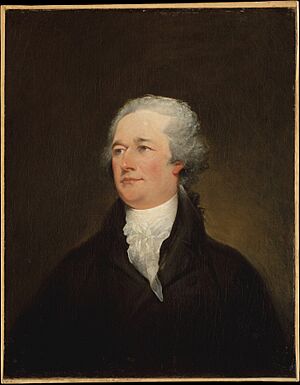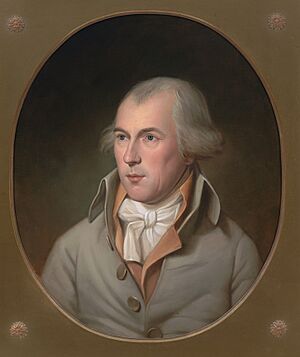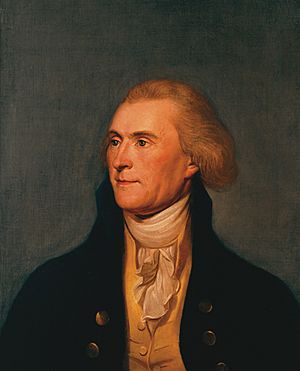Compromise of 1790 facts for kids
The Compromise of 1790 was a famous deal made by three of America's Founding Fathers: Alexander Hamilton, Thomas Jefferson, and James Madison. At the time, the new United States government was stuck. The country's leaders could not agree on two big issues.
First, Hamilton wanted the new national government to pay off all the money the states had borrowed to fight the American Revolutionary War. He believed this would show the world that the U.S. was strong and could be trusted with money. Second, Jefferson and Madison wanted the nation's new capital city to be located in the South.
The compromise was a trade. Hamilton got his plan to pay off the state debts. In return, Jefferson and Madison got the capital city built in the South, which we know today as Washington, D.C.. This important agreement helped shape the future of the United States. It is often seen as one of the most important deals in American history.
Contents
The Dinner Table Bargain
In the summer of 1790, the U.S. government was located in New York City. The members of Congress were arguing and could not pass any laws on the debt or the capital's location. To solve this problem, politicians started having secret meetings.
The most famous of these meetings is known as the "dinner table bargain." Alexander Hamilton was worried his plan to pay off the debts would fail. He asked Thomas Jefferson for help. Jefferson invited both Hamilton and James Madison to his home for dinner around June 20, 1790. At this private dinner, the three men worked out a deal to solve both problems at once.
Jefferson later wrote about what happened at the dinner:
"It ended in Mr. Madison's acquiescence in a proposition that the question [i.e., assumption of state debts] should be again brought before the house by way of amendment from the Senate, that he would not vote for it, nor entirely withdraw his opposition, yet he would not be strenuous, but leave it to its fate. It was observed, I forget by which of them, that as the pill would be a bitter one to the Southern states, something should be done to soothe them; and the removal of the seat of government to the [Potomac] was a just measure, and would probably be a popular one with them, and would be a proper one to follow the assumption."
In simpler terms, this means Madison agreed to stop fighting so hard against Hamilton's debt plan. In exchange, to make the Southern states happy about the plan, the new capital city would be moved to a location on the Potomac River, between Maryland and Virginia. As part of the deal, Hamilton also helped Virginia get a better deal on its own state debts.
Results of the Compromise
The compromise was a huge success for Hamilton and his vision for the country. His plan to have the government "assume," or take on, the states' war debts was passed into law. This was called the Funding Act of 1790. The law to create the new capital was called the Residence Act.
Paying the Debts
Hamilton's idea was to have the national government pay for all the costs of the American Revolutionary War. To do this, the government sold bonds, which are like special I.O.U.s. Wealthy people bought these bonds, which meant they were lending money to the government. This gave them a reason to want the new government to succeed.
At first, Madison was against this. He worried that letting the national government control all this money would make it too powerful, taking power away from the individual states. But the compromise changed his mind.
A Strong National Credit
After the deal was made, the plan worked just as Hamilton had hoped. The United States proved it would pay its bills. This gave the country a good reputation, or "credit," with other nations and with its own citizens.
This strong credit was very helpful later on. For example, in 1803, President Jefferson was able to borrow money from banks in Europe to pay for the Louisiana Purchase, which doubled the size of the country. The government was also able to borrow money to pay for the War of 1812.
See also
- First Report on the Public Credit
- Residence Act




